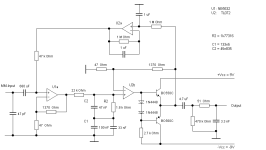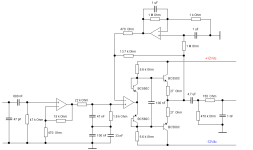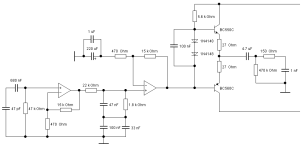Why not be bold again and simply reach into the component box?
No weeks of thinking, just have fun like a child. Just like in the old days, simply tinkering and listening to music. It's not quite that simple, because there's so much at the back of your mind ...
Design frame:
-Two-stage
-Voltage divider that bends back the cutting characteristic
-Gain about 40dB at signal frequency 1kHz
-One coupling capacitor at the input and one at the output
-Rebuildable, if it works
quite simple (KISS) and the hope that it doesn't noise - and above all works!
This problem has kept me up all night, being a 19 year old again. It's not easy to throw everything overboard and deliberately break some design rules.
Today:
I only listen via MCs, but if it works, I'll buy the nicest and cheapest MM my store has in stock.
Here's my idea, the simulation results are perfectly fine - if I haven't made a stupid mistake.
You never know.

Always be gentle,
HBt.
No weeks of thinking, just have fun like a child. Just like in the old days, simply tinkering and listening to music. It's not quite that simple, because there's so much at the back of your mind ...
Design frame:
-Two-stage
-Voltage divider that bends back the cutting characteristic
-Gain about 40dB at signal frequency 1kHz
-One coupling capacitor at the input and one at the output
-Rebuildable, if it works
quite simple (KISS) and the hope that it doesn't noise - and above all works!
This problem has kept me up all night, being a 19 year old again. It's not easy to throw everything overboard and deliberately break some design rules.
Today:
I only listen via MCs, but if it works, I'll buy the nicest and cheapest MM my store has in stock.
Here's my idea, the simulation results are perfectly fine - if I haven't made a stupid mistake.
You never know.
Always be gentle,
HBt.



